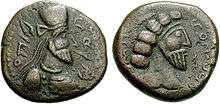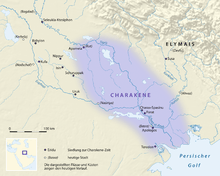Maga of Characene

Maga was a King of Characene a vassal state of the Parthian Empire and important trading city in the Persian Gulf.
He probably ruled at the end of the second century (195-210AD) and is known only from numerous coins that he minted. His coins are in a Parthian style, and the name on his coins is written in Aramaic as mʼg – which is interpreted as Maga. On these coins, he describes himself as son of a King Attambelos who is otherwise unrecorded in history. Maga is the last ruler of Characene for which there is contemporary documention.
Predecessor
Attambelos VIII was a King of Characene, who ruled around 190 AD. He is known only from the coins of his son of Maga, who calls himself son of King Attambelos. The reading of the name is, however, uncertain and reflects the poor quality of the coins of this time in general.[1]
Successor
Maga may have had possibly one successor, the twenty-third and last ruler Characene, Abinergaios III, who was defeated in 222 by a Persian, named Ardašir. Ardašir had just revolted against his Parthian overlord and was in the process of establishing the Sasanian Empire.
However, the historicity of Abinergaios III is open to question, as he known only from latter Arabic sources and Maga is the last ruler of Characene who is documented by contemporary sources. It should also be noted that the king list of Characene is a modern construct and given the known sparsity of records could well be inaccurate.[2]
Significance

Although a minor and poorly recorded vassal king on the edge of the ancient civilisations, Maga’s rule signifies an important moment in the history of civilization.
Characene was the last rump state of the Seleucid Empire. Maga, therefore, comes as the last recorded successor of Alexander the Great and the end of his rule marks the terminus of the Hellenistic Age. Although the level of Hellenisation in Charax had diminished since its conquest by Trajan a century earlier, it is still true that Alexander's last foundation was also the last point of his dreamed union of east and west. Ironically its demises came at the hands of a resurrected Persian Empire.
References
- ↑ Monika Schuol: The Characene: A Mesopotamian Kingdom in Hellenistic times. Steiner, Stuttgart 2000, page 235-236, 362-363.
- ↑ Frye, R.N., ed. (1983). The Cambridge History of Iran, Volume 3(1): The Seleucid, Parthian and Sasanian Periods. Cambridge: Cambridge University Press. p. 312. ISBN 0-521-20092-X.
| Maga of Characene | ||
| Preceded by Attambelos VIII |
King of Characene early 3rd century |
Succeeded by Abinergaios III |